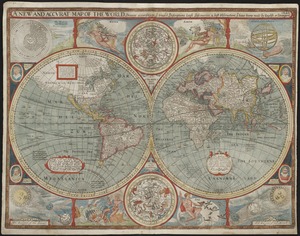Quam hic vides orbis imagine[m] lector ca[n]dide ea[m] ut posteriore[m] ita & eme[n]datiorem ijs que hactenus circu[m]ferebantur esse America sarmatiaq[ue] ac India testantur ... lemei expectato vale
Item Information
- Title:
- Quam hic vides orbis imagine[m] lector ca[n]dide ea[m] ut posteriore[m] ita & eme[n]datiorem ijs que hactenus circu[m]ferebantur esse America sarmatiaq[ue] ac India testantur ... lemei expectato vale
- Title (alt.):
-
Quam hic vides orbis imagine lector cadide ca vt posteriore ita &c. emedatiorem ijs que hactenus circuferebantur esse America sarmatiq ac India testantur
World map in double cordiform projection
Ne que ad nostram orbis diuisionen pertinebant omitteremus
- Description:
-
The Italian engraver and publisher, Antonio Salamanca, produced this finely engraved world map utilizing the double cordiform projection (heart shaped). Salamanca’s engraving was based on a 1538 map published by the noted Flemish geographer and map publisher, Gerard Mercator. Mercator’s original map, similar to Oronce Fine’s 1532 double cordiform world map, labeled both North and South America, “America” for the first time. In addition, both parts of the New World were unambiguously linked as one landmass and no longer attached to Asia.In 1569, Mercator published a 21-sheet wall map, which introduced the map projection that now bears his name. This projection was adopted by other contemporary map makers and continued to be used widely throughout the 19th century. Mercator also published numerous maps, several globes and atlases. His book of world maps, first published one year after his death, introduced the term “atlas” to the world.
- Creator:
- Salamanca, Antonio, d. 1562
- Contributor:
- Mercator, Gerhard, 1512-1594
- Date:
-
[ca. 1550]
- Format:
-
Maps/Atlases
- Location:
- Private Collection
- Collection (local):
-
Mapping Boston Collection
- Subjects:
-
World maps--Early works to 1800
Geography--Early works to 1800
- Places:
-
World
- Extent:
- 1 map ; 34 x 56 cm.
- Terms of Use:
-
No known copyright restrictions.
This work is licensed for use under a Creative Commons Attribution Non-Commercial Share Alike License (CC BY-NC-SA).

- Publisher:
-
Romae :
[s.n.]
- Scale:
-
Scale not given
- Language:
-
Latin
- Notes:
-
Relief shown pictorially.
The Italian engraver and publisher, Antonio Salamanca, who collaborated with Antonio Lafreri to create made-to-order composite map books during the mid-16th century, produced this finely engraved world map utilizing the double cordiform projection (heart shaped). Salamanca's engraving was based on a map published in 1538 by the noted Flemish geographer and map publisher, Gerard Mercator. Mercator's original map, which is now very rare, was similar to Oronce Fine's double cordiform world map published in 1531. However, there were several significant differences, particularly in terms of geographic content. Most importantly, on this map, both North and South America were labeled "America" for the first time. In addition, both parts of the New World were unambiguously linked as one land mass and the northern part was no longer attached to Asia. Amazingly, this was only Mercator's second map publication during his long and productive career. In 1569, he published a large wall map on 21 sheets which introduced the map projection that now bears his name. Although the original map utilizing this projection is very rare, the projection was adopted by other contemporary map makers and continued to be used widely throughout the 19th century. Mercator also published numerous maps and several globes and atlases. It was his book of world maps, first published in 1595 one year after his death, that introduced the term "atlas" to the world.
Exhibited in “Journeys of the Imagination,” at the Boston Public Library, Boston, MA, April - August 2006.
- Identifier:
-
05_01_000215
- Barcode:
-
39999052507330
![Quam hic vides orbis imagine[m] lector ca[n]dide ea[m] ut posteriore[m] ita & eme[n]datiorem ijs que hactenus circu[m]ferebantur esse America sarmatiaq[ue] ac India testantur ... lemei expectato vale](https://bpldcassets.blob.core.windows.net/derivatives/images/commonwealth:3f463b69r/image_access_800.jpg)



![Hemispheriu[m] ab aequinoctiali linea, ad circulu[m] Poli Arctici](https://bpldcassets.blob.core.windows.net/derivatives/images/commonwealth:3f462s45p/image_thumbnail_300.jpg)

